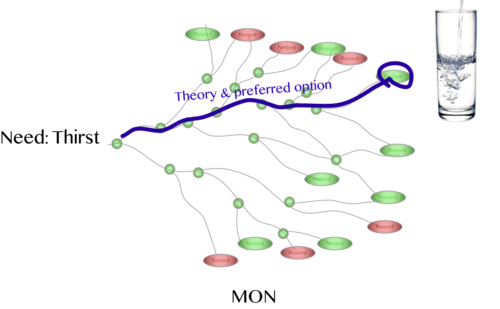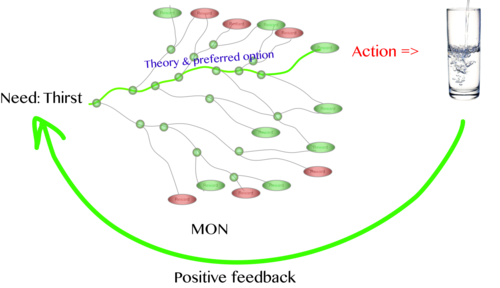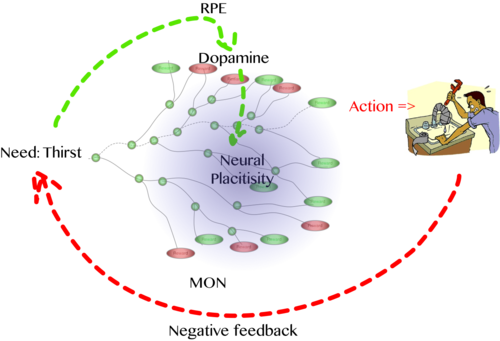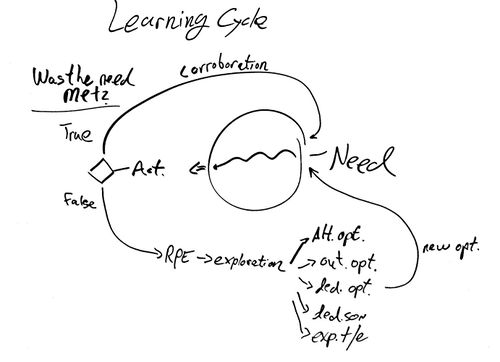Learning
From Deliberative Democracy Institiute Wiki
"Necessity is the mother of invention", William Horma, 1519
"No one Learn except that which his heart desires", Babylonian Talmud, Avodah Zarah, 19, 71, ~550 AC.
Contents
- 1 Learning Cycle
- 2 Learning and deliberation
- 3 Learning at School
- 4 Socratic dialoge
- 5 difference between experts and laymen in learning
- 6 NeuroPhysiology of Learning
- 7 Larning and Pupil size
- 8 Effective Learning
- 9 Learning with goal in mind
- 10 A paper
- 11 Measuring Knowledge
- 12 Infographic
- 13 See Aslo
- 14 References
Learning Cycle
The desire for learning emerges from attempts to fulfil needs. When one needs to drink, she will use her current theories to find options which will result an effective action which will result getting water which will fulfill the need of drinking (see brain decision making mechanisim.
She will then navigate her actions according to the theory/preferred option. If her need will be fulfilled then the theory will be corroborated.
But if the need will not be fulfilled or either the actions and reactions will not go along the theory, then an RPE/falsification will cause the theory to lose corroboration and will secret dopamine which induce learning.
Learning can occur in several ways: In the first approach, we look for another option among those known to us. If we have not found another option, we can consult and try to learn from others or from various sources on possible solutions. If we did not find a satisfactory solution, we may have to investigate the matter, and expand our knowledge, so that we can create new options.
Each of these options requires more cognitive resources then the one before. Therefore, we prefer first of all look for the possibility of that lies in our SON, then we will try to learn from others, and if it fails, we will be forced to spend resources on exploration and inventing new theories.
This solution is suitable for doers who are driven be desires to fulfill physical needs. However people that tend to think more seems to have an addiction to dopamine and are less dependent on physical needs. These thinkers will be more eager to explore and less to learn from others or do.
Learning and deliberation
The normative principles of deliberation stem from the nature of communication, which is seen as an educative process where preferences are transformed rather than aggregated[1][2]. Discussions help to educate citizens and to make them more autonomous[3][4][5][6][7].
Learning at School
Socratic dialoge
Socratic dialoge is more effective in learning then didactic teaching[8]. students explain their thinking out loud enhance their learning[9][10][11]. When using why questions and explist negative feedbeck, students learn more[12]
Learning in debate
In a study done on blamng Muslims of terror attacks, it was found that putting one self on the place of the other, can change attitude[13].
difference between experts and laymen in learning
Experts have more procedural knowledge, then laymen. When asked to solve problems, experts retrieve knowledge from long term memory to "long term working memory". Then they have to integrate current information to the working memory to result a solution. Laymen need to load both current information and procedural knowledge into the working memory, thus resulting higher load on the working memory. This overload can be detected by the speed of the solution process, as well as the speed of finding the next step in the solution[14], and I think someone measured it by pupil dilation.
NeuroPhysiology of Learning
see this papaer[15]
Larning and Pupil size
Pupil response is governed by the autonomic nervous system. Pupil dilation depends on the activation of the adrenergic sympathetic nervous system, while pupil constriction depends on the cholinergic parasympathetic nervous system[16]. It has been well documented that pupil response is modulated not only by an ambient luminance level (the so-called pupil light reflex) but also by the amount of mental effort invested in a task [17][18][19][20][21][22][23][24][25][26][27]. For example, Porter et al[28] reported that the pupil dilates when subjects conduct a difficult visual search task in which high mental effort has to be invested.
Effective Learning
See this TED video for principles of effective learning - How to learn any language in six months: Chris Lonsdale at TED.
Learning with goal in mind
see this paper.
A paper
Measuring Knowledge
Concept Maps: see good article[29]
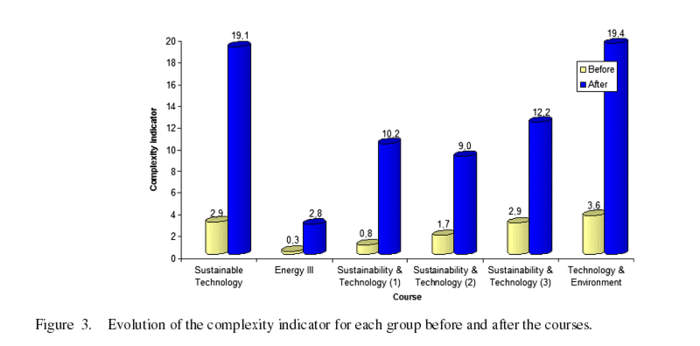
Infographic
See Aslo
- SON
- curiosty
- Handwriting is better then typing for learning: New York Times - What’s Lost as Handwriting Fades, June 2nd 2014; ScienceDaily - Better learning through handwriting, January 24, 2011
References
- ↑ Habermas, J. (1984). The Theory of Communicative Action, I, Cambridge:Polity.
- ↑ Habermas, J. (1987). The Theory of Communicative Action, II, Cambridge: Polity.
- ↑ La Due Lake, R. and Huckfeldt, R. (1998). Social Capital, Social Networks, and Political Participation, Political Psychology 19(3): 567–584.
- ↑ Paxton, P. (1999). Is Social Capital Declining in the United States? A Multiple Indicator Assessment, American Journal of Sociology 105(1): 88–127.
- ↑ Putnam, R.D. (2000). Bowling Alone. The Collapse and Revival of American Community, New York, NY: Simon and Schuster.
- ↑ Verba, S., Schlozman, K.L. and Brady, H.E. (1995). Voice and Equality: Civic voluntarism in American politics, Cambridge, MA: Harvard University Press.
- ↑ Zuckerman, A.S. (ed.) (2005). The Social Logic of Politics: Personal networks as contexts for political behavior, Philadelphia, PA: Temple University Press.
- ↑ Rosé, Carolyn P., et al. "A comparative evaluation of socratic versus didactic tutoring." Proceedings of Cognitive Sciences Society (2001): 869-874.
- ↑ Chi, Michelene TH, et al. "Self-explanations: How students study and use examples in learning to solve problems." Cognitive science 13.2 (1989): 145-182.
- ↑ Chi, Michelene TH, et al. "Eliciting self-explanations improves understanding." Cognitive science 18.3 (1994): 439-477.
- ↑ Schworm, Silke, and Alexander Renkl. "Computer-supported example-based learning: When instructional explanations reduce self-explanations." Computers & Education 46.4 (2006): 426-445.
- ↑ Rosé, C. P., et al. "The role of why questions in effective human tutoring." Proceedings of the 11th International Conference on AI in Education. 2003.
- ↑ paper in 2018
- ↑ Measuring Knowledge to Optimize Cognitive Load Factors During Instruction., S Kalyuga, J Sweller - Journal of educational psychology, 2004 - psycnet.apa.org
- ↑ [https://www.neuro.org.ar/sites/neuro.org.ar/files/Battro%202013%20MBE.pdf Battro, A. M., Calero, C. I., Goldin, A. P., Holper, L., Pezzatti, L., Shalóm, D. E., & Sigman, M. (2013). The cognitive neuroscience of the teacher--student interaction. Mind, Brain, and Education, 7(3), 177–181.
- ↑ Barbur J (2004) Learning from the pupil: studies of basic mechanisms and clinical applications. The Visual Neurosciences Vol. 1. In: Chlupa L, Werner J, editors. Cambridge: The MIT Press. pp. 641–656.
- ↑ Beatty J (1982) Task-evoked papillary responses, processing load, and the structure of processing resources. Psychological Bulletin 91: 276–292. doi: 10.1037/0033-2909.91.2.276
- ↑ Hampson RE, Opris I, Deadwyler SA (2010) Neural correlates of fast pupil dilation in nonhuman primates: relation to behavioral performance and cognitive workload. Behavioral Brain Research 212: 1–11.
- ↑ Kahneman D, Beatty J (1966) Pupil diameter and load on memory. Science 154: 1583–1585. doi: 10.1126/science.154.3756.1583
- ↑ Kahneman D, Peavler W (1969) Incentive effects and papillary changes in association learning. Journal of Experimental Psychology 79: 312–318.
- ↑ Partala T, Surakka V (2003) Pupil size variation as an indication of affective processing. International Journal of Human-Computer Studies 59: 185–198. doi: 10.1073/pnas.88.11.4966
- ↑ Porter G, Troscianko T, Gilchrist I (2007) Effort during visual search and counting: insights from pupilometry. The Quarterly Journal of Experimental Psychology 60: 211–229. doi: 10.1080/17470210600673818
- ↑ van Orden KF, Jung T-P, Makeig S (2000) Combined eye activity measures accurately estimate changes in sustained visual task. Biological Psychology 52: 221–240. doi: 10.1016/S0301-0511(99)00043-5
- ↑ van Orden KF, Limbert W, Makeig S, Jung T-P (2001) Eye activity correlates of workload during visuospatial memory task. Human Factors 43: 111–121. doi: 10.1518/001872001775992570
- ↑ Heaver, Becky, and Sam B. Hutton. "Keeping an eye on the truth? Pupil size changes associated with recognition memory." Memory 19.4 (2011): 398-405.
- ↑ Silvetti, Massimo, et al. "The influence of the noradrenergic system on optimal control of neural plasticity." Frontiers in behavioral neuroscience 7 (2013).
- ↑ Takeuchi, Tatsuto, et al. "Estimation of Mental Effort in Learning Visual Search by Measuring Pupil Response." PloS one 6.7 (2011): e21973.
- ↑ Porter G, Troscianko T, Gilchrist I (2007) Effort during visual search and counting: insights from pupilometry. The Quarterly Journal of Experimental Psychology 60: 211–229. doi: 10.1080/17470210600673818
- ↑ J. Segalàs, D. Ferrer-Balas and K.F. Mulder , 2008, Conceptual maps: measuring learning processes of engineering students concerning sustainable development
- ↑ J. Segalàs, D. Ferrer-Balas and K.F. Mulder , 2008, Conceptual maps: measuring learning processes of engineering students concerning sustainable development p.304
